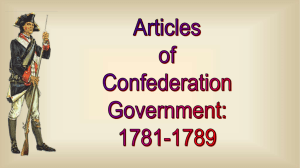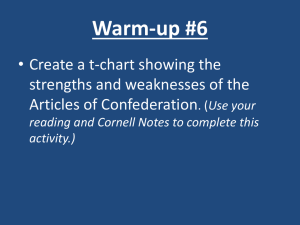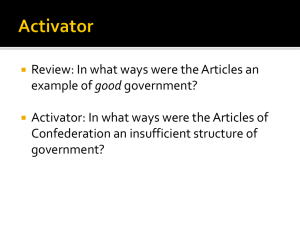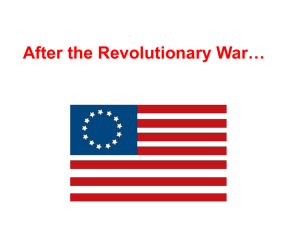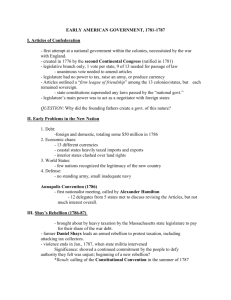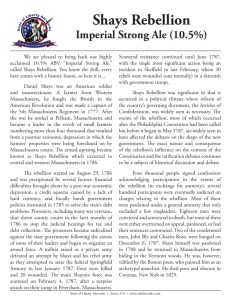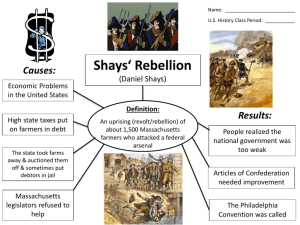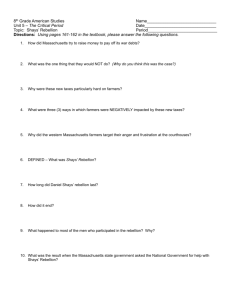shays's rebellion
advertisement
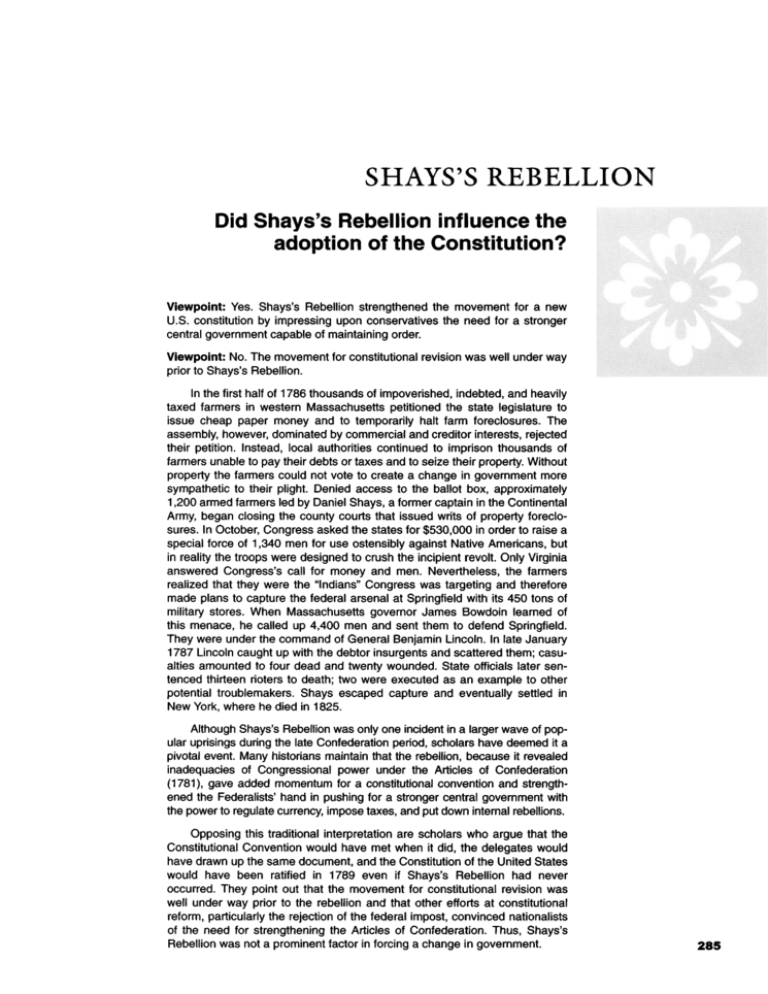
SHAYS'S REBELLION Did Shays's Rebellion influence the adoption of the Constitution? Viewpoint: Yes. Shays's Rebellion strengthened the movement for a new U.S. constitution by impressing upon conservatives the need for a stronger central government capable of maintaining order. Viewpoint: No. The movement for constitutional revision was well under way prior to Shays's Rebellion. In the first half of 1786 thousands of impoverished, indebted, and heavily taxed farmers in western Massachusetts petitioned the state legislature to issue cheap paper money and to temporarily halt farm foreclosures. The assembly, however, dominated by commercial and creditor interests, rejected their petition. Instead, local authorities continued to imprison thousands of farmers unable to pay their debts or taxes and to seize their property. Without property the farmers could not vote to create a change in government more sympathetic to their plight. Denied access to the ballot box, approximately 1,200 armed farmers led by Daniel Shays, a former captain in the Continental Army, began closing the county courts that issued writs of property foreclosures. In October, Congress asked the states for $530,000 in order to raise a special force of 1,340 men for use ostensibly against Native Americans, but in reality the troops were designed to crush the incipient revolt. Only Virginia answered Congress's call for money and men. Nevertheless, the farmers realized that they were the "Indians" Congress was targeting and therefore made plans to capture the federal arsenal at Springfield with its 450 tons of military stores. When Massachusetts governor James Bowdoin learned of this menace, he called up 4,400 men and sent them to defend Springfield. They were under the command of General Benjamin Lincoln. In late January 1787 Lincoln caught up with the debtor insurgents and scattered them; casualties amounted to four dead and twenty wounded. State officials later sentenced thirteen rioters to death; two were executed as an example to other potential troublemakers. Shays escaped capture and eventually settled in New York, where he died in 1825. Although Shays's Rebellion was only one incident in a larger wave of popular uprisings during the late Confederation period, scholars have deemed it a pivotal event. Many historians maintain that the rebellion, because it revealed inadequacies of Congressional power under the Articles of Confederation (1781), gave added momentum for a constitutional convention and strengthened the Federalists' hand in pushing for a stronger central government with the power to regulate currency, impose taxes, and put down internal rebellions. Opposing this traditional interpretation are scholars who argue that the Constitutional Convention would have met when it did, the delegates would have drawn up the same document, and the Constitution of the United States would have been ratified in 1789 even if Shays's Rebellion had never occurred. They point out that the movement for constitutional revision was well under way prior to the rebellion and that other efforts at constitutional reform, particularly the rejection of the federal impost, convinced nationalists of the need for strengthening the Articles of Confederation. Thus, Shays's Rebellion was not a prominent factor in forcing a change in government. 285 Shays's Rebellion raises some interesting questions about the nature of American politics in the late eighteenth century and its relation to the War of Independence (1775-1783). Were the Shaysites enemies of the Lockean contract theory of government upon which the Patriots had justified rebellion in 1776, or were they acting in its true spirit? Likewise, were the gentry, in suppressing the rebellion and calling for the creation of a stronger central government, upholding or butchering the republican ideology upon which the Revolution was founded? Finally, what did Thomas Jefferson mean when he remarked, in response to Shays's Rebellion, that "a little rebellion now and then is a good thing . .. and is a medicine necessary for sound health of government?" Viewpoint: Yes. Shays's Rebellion strengthened the movement for a new U.S. constitution by impressing upon conservatives the need for a stronger central government capable of maintaining order. By some measures Shays's Rebellion was a relatively minor agrarian uprising in the western and central counties of Massachusetts, lasting from late 1786 through early 1787. U.S. minister to France, Thomas Jefferson, who was living in Paris at the time, shrugged it off with the remark that "A little rebellion now and then is a good thing." The actual events of Shays's Rebellion are easily determined and are largely agreed upon by historians. Heavily taxed and debt-laden backcountry farmers were increasingly dissatisfied with their lot in the early years of the Republic. That sentiment of discontent had a long history, however, and had been building at least since before the Treaty of Paris (1783). Indeed, recent studies trace the source of Shays's Rebellion to currents of radicalism and reform flowing back to the 1740s and even to the 1691 Massachusetts charter. By the mid 1780s, partly as a result of spreading commercialism but also as a result of the economic turmoil that followed independence, social tensions in the three westernmost counties became heightened. By 1786 large numbers of yeomen had lost their farms through mortgage foreclosures or feared they would soon lose their lands. Others labored to keep afloat under unmanageable debt and even faced imprisonment. Disgruntlement was channeled into petitions, town meetings, calls to reform the state constitution, political agitation for paper money, and disruptive marches on courthousesall seemingly to no avail. Then, protest escalated to open insurrection. Under the leadership of a Revolutionary War veteran named Daniel Shays, approximately 1,200 men marched on the federal arsenal at Springfield in January 1787 to secure weapons and ammunition. When a peaceful demonstration became an armed uprising, the Massachusetts government turned to the Continental Congress for assis286 HISTORY IN DISPUTE, tance in suppressing the rebellion. Congress, however, experienced great difficulty in raising money to fund an adequate military force. In Massachusetts and elsewhere, that failing illustrated to many observers the ineffectiveness of Congress's powers as established under the Articles of Confederation (1781). The uprising ended when it was suppressed with minimal bloodshed in late January and February 1787 in confrontations at the Springfield Armory and on Petersham Field. Almost all modern historians and political scientists agree that Shays's Rebellion had a significance that goes well beyond its immediate effects on those who directly participated in these military actions. Although it had disparate consequences, Shays's Rebellion significantly advanced the ratification of the Constitution of the United States. Many Americans in the 1780s, conservatives and liberals alike, began to ponder whether the Articles of Confederation provided an adequate framework for the new American Republic. Federalists thought a strong national government was needed. That trend was quickened by the environment of crisis and uncertainty associated with Shays's Rebellion. With a stronger central government, leaders thought rebellions could more easily be put down. With greater power concentrated in the central government, others argued, economic activity in the entire country might be bolstered, making the chance less likely that rebellions need break out in the first place. In the minds of others, the darkest fear instilled by the rebellion was that the loose "league of friendship" of the Articles was such that it left American liberty overly vulnerable to demagogues such as Shays. Not the least important effect of Shays's Rebellion, as historian David P. Szatmary has shown, was its impact on local leaders within the individual states. Before 1786 politicians in Massachusetts had shown themselves reluctant to throw their support behind a stronger national government. A centralized government, they reasoned, would necessarily detract from the regional power bases whose support local leaders enjoyed. The rebellion, and the threat to security on a national level that accompanied it, led many of these local leaders to see things in a different VOLUME 12: THE A M E R I C A N R E V O L U T I O N light. That effect was felt well beyond Massachusetts. In Connecticut, for instance, Shays's Rebellion had a determining effect, changing the minds of men such as Joseph Hopkins and William Williams, both delegates to their state's ratification convention, which approved the Constitution on 9 January 1788. Well beyond New England, in Virginia, ratification convention delegate William Grayson, who initially opposed the federal charter but later served as a U.S. senator, summarized how many local leaders felt: "The disturbances in Massachusetts Bay have been considerable, and absolutely threaten the most serious consequences. . . . How it will end, God only knows; the present prospects are, no doubt, extremely alarming." As historian Andrew Cunningham McLaughlin artfully summarized: "Shays's rebellion merits attention . . . because it was the conspicuous uprising that startled the thoughtful men of every state and made them wonder what the end of their great war for independence might prove to be." In this way Shays helped create an atmosphere in which wholesale constitutional revision was possible. For those who already believed in the virtues of a strong federal government, the alarming events of 1786 and 1787 did nothing to change their minds; it served only to confirm and galvanize their beliefs. Virginian Federalist leader James Madison saw things in a similar light when he suggested that the rebellion provided in vivid colors "new proofs of the necessity of such a vigor in the general government as will be able to restore health to any diseased part of the Federal body." Shays's Rebellion, then, led many of America's political elite to see more clearly the necessity of a stronger Congress. Just as important was the effect of Shays's Rebellion on the public at large. As a contemporary observer reported, "I never saw so great a change in the public mind on any occasion as has lately appeared in this state as to the expediency of increasing the powers of Congress, not merely to commercial objects but generally." Virginia planters and politicians George Washington and Edward Carrington argued at the time that Shays's Rebellion immeasurably raised the political importance of the planned convention in Philadelphia. In the environment of the rebellion the convention was able to attract delegates from across the commonwealth. As a result of the disturbances caused by Shays's Rebellion, Washington said, "most of the legislatures have appointed and the rest will appoint delegates to meet at Philadelphia." The sense of urgency injected by the rebellion was something that had been missing during the prerebellion Annapolis Convention (1786). As historian Jackson Turner Main has shown in his classic study of the Antifederalists, H I S T O R Y IN D I S P U T E , V O L U M E 12: THE A M E R I C A N R E V O L U T I O N Woodcut of Daniel Shays (left) and his chief subordinate, Job Shattuck, 1787 (National Portrait Gallery, Smithsonian Institution, Washington, D.C.) 287 at least twenty-nine of the delegates that met at Philadelphia had been supporters of the rebellion. Given that fact, one might expect that the rebellion would be discussed explicitly at the Convention—and it was. It also figured in the debates in other ways, such as when delegates discussed paper money and, more important, the use of federal military force to quash future rebellions within the states. Memories of Shays's Rebellion continued to exert influence when time came to ratify the Constitution. In Massachusetts, where the rebellion had further polarized the political community, Antifederalist sentiment would be attractive to a significant percentage of the population who were opposed to the commercial interests of the East, with whom they associated the new constitution. Henry Jackson argued that "The whole opposition, in this commonwealth, is that cursed spirit of insurgency that prevailed last year." At the Massachusetts ratifying convention, for instance, Josiah Smith, a delegate from Pembroke, argued that the Constitution must be ratified in order to avoid the "effects of anarchy" that had accompanied Shays's Rebellion. In newspapers and other venues for public debate, Shays's Rebellion was used time and again by Federalists to show the dangers that might be expected should the Constitution be rejected. Not only in New England but also in New York and other states, a similar image emerged. Newspapers such as the Pennsylvania Chronicle described Antifederalists as "Shaysites in principle & practice, who are averse to any Government." Twentieth-century scholars have demonstrated such claims to be inaccurate. As historian James Leamon has rightly argued, Federalists writing in late 1787 tended not to draw careful distinctions between Shaysites and Antifederalists. In their carelessness and overstatements, however, these eighteenth-century authors illustrate that the memory of Shays's Rebellion continued to serve purposes in the debate about ratification. A reasoned assessment of the evidence shows that Shays's Rebellion had an impact upon the Constitution in many ways. In illustrating the weakness of Congress under the Articles of Confederation, the uprising provided a significant impetus for many state leaders to support the call for a constitutional convention. The rebellion gave a sense of urgency to that process and also had a direct bearing on the discussions in Philadelphia in 1787. It set part of the agenda and helped shape the document that resulted from those discussions. Finally, Shays's Rebellion influenced the public debates which preceded ratification of the U.S. Constitution. -MARK SPENCER, BROCK UNIVERSITY 288 Viewpoint: No. The movement for constitutional revision was well under way prior to Shays's Rebellion. "Shays's protest was put down forcefully but it helped lead to the adoption of the United States Constitution," President Ronald Reagan declared in a bicentennial homage to the eighteenth-century tax revolt. Reagan, a Republican, had won his two presidential elections with campaigns that courted the "New Right," a combination of the wealthy and working class and suburban and rural voters. He promised tax cuts for corporations and the upper classes and employed Cold War patriotic, military, and religious appeals to working-class and rural Americans. The President thus used eighteenth-century history, particularly Shays's Rebellion—a tax revolt by poor rural farmers—and the Constitution to serve his twentieth-century political ends in the "Reagan Revolution." The Constitution, the president continued, is "a blueprint for freedom giving each of us the right to help direct the course of our government to fight against injustice, if you will, without having to lead an armed revolution." Paradoxically, Reagan's revisionist affinity would have bewildered Daniel Shays's contemporaries. Shaysites in Massachusetts bitterly opposed the federal Constitution, and as Antifederalists in the state ratifying convention they nearly sent it down to defeat. Rather than a "blueprint for freedom," they regarded it as an elitist conspiracy among merchants, planters, lawyers, and politicians whose goal was "the establishment of two Orders in the Society," reported a dismayed Federalist Rufus King, "one comprehending the Opulent and Great, the other the poor and illiterate." Americans in 1787 would have also disagreed with the future President's contention that the insurrection "helped lead to the adoption" of the Constitution. In fact, in Massachusetts and in other states where Shays-like court closings and rioting occurred, the state governments' economic policies, their use of the law to enforce them, and their employment of troops to repress uprisings actually galvanized Antifederalist opposition to the Constitution in 1787-1788. Yet, one should not be too hard on the president, since he was only reiterating what a long line of distinguished historians had argued for more than a century. John McMaster, Charles A. Beard, Merrill Jensen, Jackson Turner Main, Clinton Rossiter, John C. Miller, and David Szatmary all drew lines of causation between Shays's Rebellion and the success of the Constitutional Convention (1787). Indeed, to argue that the rebellion had no HISTORY IN DISPUTE, VOLUME 12: THE A M E R I C A N R E V O L U T I O N HOW CAN IT BE OTHERWISE On 16 January 1786 a group of farmers from Greenwich, Massachusetts, petitioned state authorities to provide economic relief: We are sencable also that a great debt Is justly brought upon us by the war and are as willing to pay our shares towards itt as we art to injoy our sham in indeperaferoy and constatutional priviledges in the Commonwealth, if itt was In our power. And we beleve that If prudant mesuers ware taken and a moderate qyantety of medium to circulate so that our property might sei for the real value we mite In proper time pay said debt But with the greatest submittion we beg leave to informe your Honours that unles something takes place more favourable to the people, in a little time att least, one half of our inhabitants in our opplnion will become banckerupt—how can Itt be otherwise—the constables are dayly vandertng [vendeting, i.e., selling] our property both real and personal, our land after itt is prised by the best judges under oath is sold for about one third of the value of Itt, our cattle about one half tie value, the best inglesh [English] hay thirteen shilings per tone, Intervale [native] hay att six shilings per tone, and other things att the same rate, And we beg leave further to informe your honours that sutes att law are very numerous and the attumeys in our oppinlon very extravigent and oppressive in their demands. And when we compute the taxes laid upon us the five preceeding years: the state and county, town and class taxes, the amount is equii to what our farms will rent for. Sirs, in this situation what have we to live on—no money to be had; our estates dayiy effect on the Constitution, as historian Robert A. Peer attempts to do in his essay, "Shays's Rebellion and the Constitution: A Study in Causation," would be impossible. Peer contends that "in all likelihood, the Constitutional Convention would have met when it did, the same document would have been drawn up, and it would have been ratified even if Shays's Rebellion had not taken place." In order to make this case, Peer engages in counterfactual argument, speculating on what would have happened if the facts of the story had been different. History, however, is the study and analysis of the recorded past in order to determine what actually happened and what factors shaped that reality. posted and sold, as above described. What can your honours ask of us unles a paper curancy or some other medium be provided so that we may pay our taxes and debts. Suerly your honours are not strangers to the distresses of the people but doe know that many of our good Inhabitants are now confined in gole for del and for taxes: maney have fled, others wishing to flee to tie State of New York or some other State; and we believe that for two yearn past four inhabitants have removed from this State to some other State to one that has come from some other State to settle in this State. Honoured Sirs, are not thsse imprisonments and fleeing away of our good inhabiterrts vary injurious to tha credit or honour of the Commonwealth? will not the people in the neighbouring States say of this State: altho* the Massachusets bost of their fine constatution, their government 1$ such that Itt devours their inhabitents? Notwithstanding all these distresses, we hear of no abatement of sallerys, but his Excellency the Governor must be paid alaven hundred a year out of the moneys collected at before mentoned, and other sallerys and grants to other gentleman, as your honours very well know, Iff these things are honest, just and rite, we sincearly wish to be convinced of itt: but we honestly confess itt is beyond our skill to reconsile these sallerys and grants with the principles of our Constitution (viz.) piaty, justice, moderation, temperance, ate.., „ Source: Richard D. Brown, ed., Major Problems In the Era of Urn American Revolution, 1T6CM791 (Lexington, Mam.: 0, C, Hmmf 1992), p. 4m Shays's Rebellion broke out during the interim between the Annapolis Convention (1786), called to consider the addition of coordinated commercial regulations to the Articles of Confederation (1781), and the Constitutional Convention, called to consider amendments to augment the power of the Confederation Congress. The principal actors at Philadelphia—nationalists such as James Madison, George Washington, and Alexander Hamilton—all remarked on the seriousness of the rebellion and the fact that it revealed the need for a stronger federal union. At the same time, however, the rebellion convinced many others that a powerful central government would do more harm than good. Although the HISTORY IN DISPUTE, VOLUME 12: THE A M E R I C A N R E V O L U T I O N 289 rebellion influenced the construction and ratification of the Constitution, it did so in ways and degrees that differ from the traditional view. First, the impulse for reform existed long before Shays and his men marched on Springfield, so the rebellion merely enhanced the Philadelphia Convention; it did not inspire it. Second, the rebellion activated the Constitution's democratic, state-centered opponents as well as its republican, nationalist advocates. And third, those opponents in Massachusetts nearly defeated the plan for union, but in their opposition they democratically altered its character by demanding a Bill of Rights to preserve the power of the people and the states. Historians such as Gordon S. Wood and Lance Banning have argued that the Founders' reformism had deeper ideological, political, and economic roots that reached back to the earliest years of the Confederation. They argue that Shays's Rebellion was important in the winter of 1787 for impressing upon state governments the need to send delegates to the upcoming convention, as the Congress charged, "for the sole and express purpose of revising the Articles of Confederation" to "render the federal constitution adequate to ... the preservation of the Union." The rebellion, however, represented only one symptom of a pervasive, national illness. Historian Stephen E. Patterson agrees that "Shays's Rebellion . . . was less a cause of Federalism than it was an opportunity to expand and popularize it." More than one historian has termed the Confederation era as the "critical period" in American history. The nation labored under staggering domestic and international war debts; England blocked trade with the British West Indies (previously the heaviest consumers of American products); Spain closed the Mississippi River to trans-Appalachian American commerce; and British troops remained in Western posts. All of these factors hampered Congressional efforts to raise revenue through the sale of Western lands, which thwarted attempts to repay the domestic and international debt. It was a vicious cycle that threatened the security of the Confederation. To make matters worse, many state governments were unable or unwilling to enact fiscal legislation that would be responsive to long-term national needs, and instead served the short-term interests of their constituents. This recalcitrance was the crisis that men such as Madison, Washington, Hamilton, and other nationalists perceived. In their transition from colonies to republics, the state governments wrote constitutions that broadened both the franchise and the size of their representative assemblies. This state-centered commitment to popular sovereignty, the nationalists feared, placed too much power in the hands of average citizens who in troubled times tended to vote for their individual pocketbook interests at the 290 expense of the common good. The Confederate system, with no power to check the state democracies, had transformed popular sovereignty from a virtue into a vice. The Continental Congress, sanctioned by the Articles of Confederation, was not a central government. It was not a legislature; it could not pass laws for the states or for the people, only resolutions with which the state governments could comply, or not, through their own legislation. Likewise, Congress could not levy taxes. It could only requisition payments from the states, which could comply, or not, by taxing their citizens. Congress had no power to enforce its resolutions or requisitions. Congress requested payments in specie (hard currency, gold or silver coin) in order to satisfy its creditors. During the "critical period," however, most states and their citizens were cash poor and thus could not meet their requisitions, so the Confederation's debts continued to mount. Deepening the crisis, many states passed debtor-friendly economic programs. Some states printed paper money and made it legal tender for debt settlement along with specie; other state legislatures codified debtor-relief laws to reduce the burden on their constituents. The people controlled the states, and the people wanted immediate local relief more than eventual national recovery. In order to satisfy the creditors and pull the nation out of its postwar economic depression, Congressional delegations worked to bypass the states by creating an independent source of revenue. The Superintendent of Finance, Robert Morris, suggested a national impost on foreign imports. All of the states would have to pass legislation providing for the impost for the measure to take effect, but that unanimity never materialized. In 1781 Rhode Island opposed the legislation, and in 1783 Virginia stood in the way. By 1786 all states except New York had signed on, but in April the Empire State defeated the impost, and most legislators in Congress feared that the issue was dead. In the meantime, Congress sent John Jay to Spain in 1784 to negotiate a treaty for free American navigation of the Mississippi River. The treaty that he crafted with Don Diego de Gardoqui in 1786 opened ports in the Spanish Empire to American trade in exchange for continued Spanish control of the Mississippi River for a period of twenty-five years. Instead of securing navigation rights, Jay used them as a bargaining chip for what he and many other nationalists viewed as a greater economic prize. The Jay-Gardoqui Treaty, however, eventually met the same fate as the impost. Southern states, with broad claims to lands in the Southwest, believed that the treaty sold their future for the immediate commercial benefits of the Northeast and refused to ratify. As with the impost, nationalists interpreted the fail- H I S T O R Y IN D I S P U T E , V O L U M E 12: THE A M E R I C A N R E V O L U T I O N ure of the treaty as yet another example of powerful democratic states serving their own interests before those of the nation. Thus, by the summer of 1786, the debts continued to mount, Western lands remained unsold, and trade still floundered as many state governments failed to meet their requisitions, printed deflationary paper currency, and passed debtorrelief laws. Massachusetts, of course, was not one of those states, as it ignored the democratic pleas for debtor-relief, adhered to specie, prosecuted tax delinquency, and helped creditors foreclose on bankrupt debtors. Massachusetts was the exception, however, and it was that exception that nationalists in Congress had hoped to emulate since the state adopted its conservative constitution in 1780. Even states such as Virginia and New Hampshire in their constitutional revisions of 17831784 sought to emulate Massachusetts^ strong executive and strict separation of powers that checked the popularly elected legislature. Pennsylvania, with the most democratic of the state constitutions, began to move to check the power of the people in 1783 in a reform movement that culminated in a new constitution later in the decade. Nationalists such as Morris, Hamilton, Madison, Washington, and Benjamin Rush had all long wished for greater Congressional power at the expense of the states. Conventions to explore ways to enhance the Congress were held at Springfield, Massachusetts (1777), New Haven, Connecticut (1778), and Hartford, Connecticut (1780). In 1782 Hamilton and the New York delegation called for a General Convention, and in 1783 General Washington endorsed it. In 1784 Virginia called for a General Convention and was joined in 1785 by Massachusetts, but it was not until 1786, after the failures of both the impost and the Jay-Gardoqui Treaty but before the outbreak of rebellion in Massachusetts, that two-thirds of the states agreed to convene at Annapolis, Maryland, in September to "take into consideration the trade of the states" and to devise a "uniform system in their commercial regulations." Madison and Hamilton were the two principal delegates at the convention, and as historians Banning, Rossiter, and Wood have shown, they planned to increase the scale and the scope of the Congressional instructions at Annapolis. On 14 September, with only five delegations present and with knowledge that four more were on the way, Madison and Hamilton pushed the Convention to an early dismissal, and Hamilton authored their report to Congress suggesting that delegates from all of the states should "meet at Philadelphia on the second Monday in May next . . . to take into consideration the situation of the United States, to advise such further provisions . . . to render the Constitution of the federal government adequate to the exigencies of the Union." The nationalists already began to play their hand as the Massachusetts farmers had only started obstructing the courts. The rebels did not assemble in arms to threaten the Springfield arsenal for another four months. Before that, seven states provided delegations for Philadelphia, and five others waited until after the official Congressional call for delegates that came in a 21 February resolution. The battles in Massachusetts between 25 January and 4 February did not stir an immediate rush to constitutional reform. For people who were nationally oriented, Shays's Rebellion seemed just another example of self-interested, unvirtuous Americans who refused to sacrifice for the national common welfare and thus confirmed their desires for constitutional reform. For locally oriented people the plight of the Massachusetts farmers represented the future for all ordinary Americans should a stronger, less democratic union arise. Therefore, if the rebellion aided nationalists in Congress by prodding along the February resolution, it by no means assured popular acceptance of a strong, federal union. These sentiments were especially true in Massachusetts, home to the prototype of the federal constitution and to Shays's Rebellion. Patterson writes that "the Federalist movement was growing incrementally: from a core of merchants, the movement expanded outward, absorbing the interests of artisans and lawyers and . . . of bankers and financiers, of holders of public securities, and of army officers," all of whom supported the impost and the Jay-Gardoqui Treaty. When the debt-ridden Western farmers rose against the government and the eastern moneyed interests it represented, centrists not just supported military suppression of the rebellion but passed the Disqualifying Act to prevent convicted rebels from voting in the 1787 elections. No matter, such repression led to a rural Shaysite victory at the polls that year and stacked the Massachusetts Ratifying Convention in January 1788 with Shaysites and their sympathizers who nearly prevented ratification. They only narrowly approved the document (187 to 168) after their popular new governor, John Hancock, suggested ratification upon the condition of amendment with a Bill of Rights. Without that addition, failure in Massachusetts seemed certain, and would have been a blow to the Constitution, as other "large states" such as New York and Virginia had yet to ratify. Historian Richard D. Brown comments that the "fact that the Shays movement and its repression had mobilized a wave of Antifederalism that had nearly blocked the ratification of the Constitu- H I S T O R Y IN D I S P U T E , V O L U M E 12: THE A M E R I C A N R E V O L U T I O N 291 tion in the crucial state of Massachusetts" has been "conveniently forgotten." and William M. E. Rachal (Chicago: University of Chicago Press, 1977). -PAUL DOUGLAS NEWMAN, UNIVERSITY OF PITTSBURGH AT JOHNSTOWN Jackson Turner Main, The Antifederalists: Critics of the Constitution, 1781-1788 (Chapel Hill: University of North Carolina Press, 1961). References Lance Banning, The Sacred Fire of Liberty: James Madison and the Founding of the Federal Republic (Ithaca, N.Y.: Cornell University Press, 1995). John L. Brooke, "To the Quiet of the People: Revolutionary Settlements and Civil Unrest in Western Massachusetts, 1774-1789," William and Mary Quarterly, 3rd series, 46 (1989): 425-462. Richard D. Brown, "Shays's Rebellion and the Ratification of the Constitution in Massachusetts," in Beyond Confederation: Origins of the Constitution and American National Identity, edited by Richard Beeman, Stephen Botein, and Edward C. Carter II (Chapel Hill: University of North Carolina Press, 1987). Robert A. Peer, "Shays's Rebellion and the Constitution: A Study in Causation," New England Quarterly, 42 (September 1969): 388-410. Robert A. Gross, "The Uninvited Guest: Daniel Shays and the Constitution," in In Debt to Shays: The Bicentennial of an Agrarian Rebellion, edited by Gross (Charlottesville: University Press of Virginia, 1993), pp. 1-43. James Leamon, "In Shays's Shadow: Separation and Ratification of the Constitution in Maine," in In Debt to Shays: The Bicentennial of an Agrarian Rebellion, edited by Gross (Charlottesville: University Press of Virginia, 1993), pp. 281-296. Library of Congress, Journals of the Continental Congress, 1774-1789, volume 33, edited by Roscoe R. Hill (Washington, B.C.: Government Printing Office, 1904-1937). Michael Lienesch, "Reinterpreting Rebellion: The Influence of Shays's Rebellion on American Political Thought," in In Debt to Shays: The Bicentennial of an Agrarian Rebellion, edited by Gross (Charlottesville: University Press of Virginia, 1993), pp. 161182. James Madison, The Papers of James Madison, volume 10, edited by William T. Hutchinson 292 Forrest McDonald, We the People: The Economic Origins of the Constitution (Chicago: University of Chicago Press, 1958). Andrew Cunningham McLaughlin, The Confederation and the Constitution (New York & London: Harper, 1905). Stephen E. Patterson, "The Federalist Reaction to Shays's Rebellion," in In Debt to Shays: The Bicentennial of an Agrarian Rebellion, edited by Gross (Charlottesville: University Press of Virginia, 1993), pp. 101-118. William Pencak, "The Fine Theoretic Government of Massachusetts is Prostrated To The Earth': The Response to Shays's Rebellion Reconsidered," in In Debt to Shays: The Bicentennial of an Agrarian Rebellion, edited by Gross (Charlottesville: University Press of Virginia, 1993), pp. 121-143. J. R Pole, "Shays's Rebellion and the Problem of Opposition Politics," in Major Problems in the Era of the American Revolution, 17601791: Documents and Essays, edited by Brown (Lexington, Mass.: B.C. Heath, 1992), pp. 447-455. Clinton Rossiter, 1787: The Grand Convention (New York: Macmillan, 1966). David J. Siemers, Ratifying the Republic: Antifederalists and Federalists in Constitutional Time (Stanford, Cal.: Stanford University Press, 2002). David P. Szatmary, Shays' Rebellion: The Making of an Agrarian Insurrection (Amherst: University of Massachusetts Press, 1980). Charles C. Tansill, ed., Documents Illustrative of the Formation of the Union of the American States (Washington, D.C.: Government Printing Office, 1927). Charles Warren, "Fears of Disunion," in Essays on the Making of the Constitution, edited by Leonard W. Levy (New York: Oxford University Press, 1969), pp. 33-43. Joseph Parker Warren, "The Confederation and the Shays Rebellion," American Historical Review, 9 (October 1905): 42-67. Gordon S. Wood, The Creation of the American Republic, 1776-1787 (Chapel Hill: University of North Carolina Press, 1969). H I S T O R Y IN D I S P U T E , V O L U M E 12: THE A M E R I C A N R E V O L U T I O N
